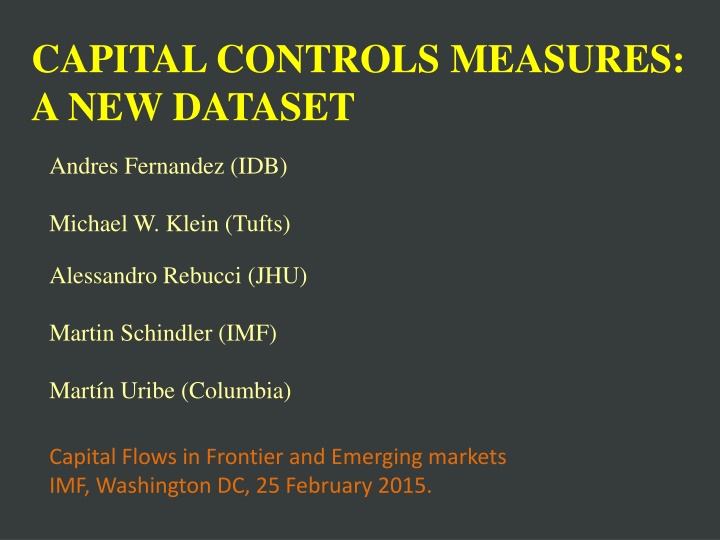
Capital Controls Measures in Emerging Markets
Explore a new dataset on capital controls measures in emerging markets, including motivations, contributions, and asset categories. Learn about differential treatments of residents and non-residents, asset categorizations, coding rules, and more. The dataset includes detailed criteria and rules based on IMF AREAER, providing insights into the effectiveness of capital control policies and their impact.
Download Presentation

Please find below an Image/Link to download the presentation.
The content on the website is provided AS IS for your information and personal use only. It may not be sold, licensed, or shared on other websites without obtaining consent from the author. If you encounter any issues during the download, it is possible that the publisher has removed the file from their server.
You are allowed to download the files provided on this website for personal or commercial use, subject to the condition that they are used lawfully. All files are the property of their respective owners.
The content on the website is provided AS IS for your information and personal use only. It may not be sold, licensed, or shared on other websites without obtaining consent from the author.
E N D
Presentation Transcript
CAPITAL CONTROLS MEASURES: A NEW DATASET Andres Fernandez (IDB) Michael W. Klein (Tufts) Alessandro Rebucci (JHU) Martin Schindler (IMF) Mart n Uribe (Columbia) Capital Flows in Frontier and Emerging markets IMF, Washington DC, 25 February 2015.
Motivation Continued debate and renewed interest in capital controls Emerging market crises Global financial crisis Theoretical literature (Trilemma, Pecuniary externalities) Interest in understanding what countries are doing and what are the effects of these policies Need data to describe policies, assess their effectiveness and test new theories!
Contribution of this paper New annual capital control data set, updating, expanding, and revising Schindler (2009), FRU (2013) and Klein (2012) 9 more countries relative to FRU (2013) 7 more years of data (1995-2013) relative to Schindler (2009) 4 more asset categories (10 in total now) relative to Schindler (2009) and FRU (2013) Spelled out detailed set of criteria and rules to code based on IMF AREAER Describe some features of the data
Outline The data Assets categories Transaction categories Coding rules Aggregation Some properties of the data Conclusions
Capital controls: differential treatment of residents & non-residents Administrative Outright prohibitions Authorizations, permissions, clearances Licensing requirements Market-Based Taxes Brazil s IOF tax Chile s encaje 1992 1998 Thailand 15% withholding tax on interest payments and capital gains on bonds held by foreign investors (introduced 10/2010
Asset categories Money Market (mm): Maturity one year or less (e.g. certificates of deposit, treasury bills, commercial papers, interbank deposits, and repurchase agreements). Bonds (bo): original maturity of more than one year. Equities (eq): Shares, other securities if not DI. Collective Investments (ci): Share certificates, registry entries, other collective investment (e.g. mutual funds, investment trusts). Derivatives (de): e.g. options, futures, forwards, warrants, str. fin. Financial Credits (fc): Credits other than cc, including banks. Real Estate (re): Not DI (e.g. Personal or for Financial Investment) Commercial Credits (cc): Linked with trade in goods or services Guaranties, Sureties & Financial Backup Facilities (gs): Securities pledged for payment or performance, or financial guarantees. Direct Investment (di): Lasting relations for investor management, e.g. wholly owned enterprise, subsidiary, branch, acquisition.
Coding the AREAER Information We follow Schindler (2009), and we use the narrative description in AREAER We formulated rules consistent with those originally used by Schindler (2009), elaborating them if needed (and revising the data backward as necessary)
Aggregation While the data base is granular, with 32 categories in total, one can aggregate as desired. In the paper we define inflows and outflows based on direction of flows and then construct indexes taking simple averages:
Open/Gate/W all Designations Values of Average CCM Open: 0 0.10 Gate: 0.11 0.69 Wall: 0.70 1.00
Incidence of controls (Share of observations with controls)
Controls on inflows Figure 2a: Average Controls on Inflows by Income Group Averages Across 10 Asset Categories .25 Average Across 10 Asset Categories .65 .6 .55 .2 .5 .45 .4 .15 1995 1998 2001 2004 2007 2010 2013 High(42) (Left Axis) Lower Middle(24) (Rt. Axis) Upper Middle(26) (Rt. Axis) Low(8) (Rt. Axis)
Controls on outflows Figure 2b: Average Controls on Outflows by Income Group Averages Across 10 Asset Categories .8 Average Across 10 Asset Categories .22 .2 .7 .18 .6 .16 .5 .14 .12 .4 1995 1998 2001 2004 2007 2010 2013 High(42) (Left Axis) Lower Middle(24) (Rt. Axis) Upper Middle(26) (Rt. Axis) Low(8) (Rt. Axis)
Correlation between (and within) inflows and outflows
Comparison with other indicators Other de jure indicators also use AREAER information, but do not distinguish among asset or transaction categories, or between inflows and outflows Dennis Quinn (1997, 2011): Reads narrative of AREAER to get intensity of capital controls for capital account receipts and payments. Range [12.5,100] in increments of 12.5 Menzie Chinn and Hiro Ito (2006, 2008): 1st Principal Component of AREAER Codings of Current Account Transactions, Capital Account Transactions, Presence of Multiple Exchange Rates, Requirements for Surrendering Export Proceeds. Range [-1.86, 2.46] Both converted to [0,1] for purposes of comparison.
Conclusions New data set on capital controls: most comprehensive data set available based on IMF reports Can be easily expanded with more countries, updated, or coded at different frequency as we have honed and tracked the coding rules Only started to explore it There is plenty to investigate with these data 23






















